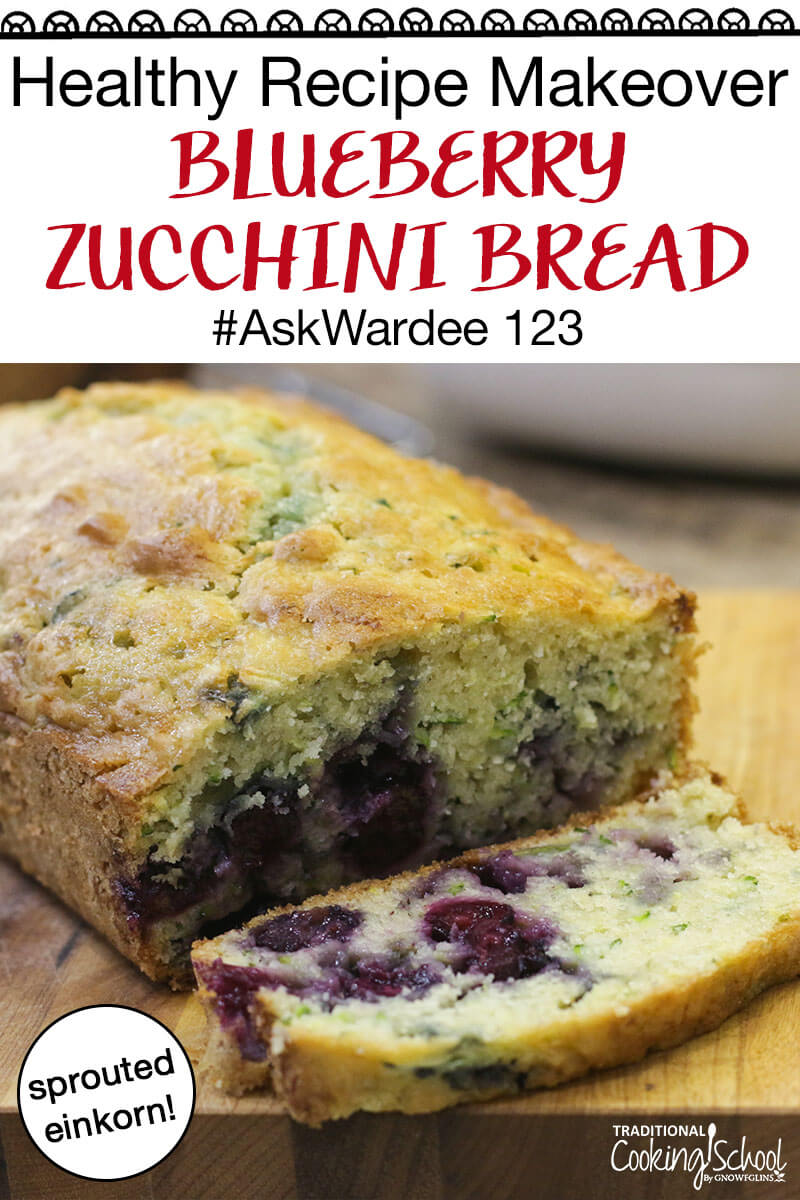
Gina asked, “I have my favorite zucchini bread recipe below. I’m new to soaking and would like to know how you would modify this to soak the flour portion. I would also like to try to make it with einkorn.”
This looks like a great recipe, Gina!
I’d love to help you convert it to Traditional Cooking methods.
And I’m showing you how on today’s #AskWardee!
Subscribe to #AskWardee on iTunes, Stitcher, YouTube, or the Podcasts app.
The Question: Zucchini Bread Healthy Makeover
Gina N. asked:
I have my favorite zucchini bread recipe below. I’m new to soaking and would like to know how you would modify this to soak the flour portion. I would also like to try to make it with einkorn.
Blueberry Zucchini Bread
3 eggs lightly beaten
1 cup oil
3 tsp vanilla
2 1/2 cups sugar
2 cups shredded zucchini
3 cups flour
1 tsp salt
1 tsp baking powder
1/4 tsp baking soda
1 TBS cinnamon
1 pint fresh blueberriesPreheat oven to 350 degrees and grease 4 mini loaf pans
Beat together eggs, oil, vanilla and sugar. Fold in zucchini. Beat in the flour, salt, baking powder, baking soda, and cinnamon. Gently fold in blueberries. Transfer to prepared pans.
Bake 50 minutes. Cool 20 minutes, then turn out onto wire racks to cool (if they last that long).
Looks like a great recipe, Gina!
In fact, I had to make it myself to show off the “makeover” on today’s #AskWardee. 🙂
Why Soak?
Gina is asking how to incorporate “soaking” into this recipe.
She asks because she knows that in Traditional Cooking, we use methods like soaking, sprouting, and fermenting (sourdough) to make grains and flour more digestible and nutritious.
(By the way, those methods are listed in the order of effectiveness, with sourdough is the most effective, yet all of them helping significantly.)
In soaked flour recipes, you combine the flour, liquid (usually water), and an acid, and let that “soak” overnight or for 7 to 8 hours. During this time, the anti-nutrients in the grain such as phytic acid (which blocks mineral absorption) are neutralized.
In sprouting, the whole grains — before ground into flour — are soaked, drained, and then allowed to sprout. Then they are dehydrated, and then ground into flour. The sprouting process made the grains more nutritious and digestible.
And finally, in sourdough, the flour is combined with a sourdough starter (here are free instructions) and the beneficial yeasts and bacteria in the starter do the work of making the flour more digestible and nutritious.
When we, like Gina, have old family recipes that you want to make more nutritious, we often try to improve them in a couple ways:
- By using whole food and unprocessed ingredients — like butter for shortening, healthy oil for canola oil, unrefined sweeteners instead of white sugar, etc.
- By incorporating soaking, sprouting, or fermenting/sourdough into the recipe.
Now Gina is asking specifically to create a soaked version of her Blueberry Zucchini Bread, so let’s talk about that.
Blueberry Zucchini Bread Makeover
Water or a similar liquid is required if we were to update your recipe with a soaking step (or sourdough). Because the soaking step requires combining flour with water and an acid and leaving to soak overnight.
Unfortunately, Gina, when I look at your recipe, I don’t see any water. I see oil, but that doesn’t work for soaking or sourdough.
So that means we have to look at sprouting. And in fact, with recipes like this — quick breads and cookies — I prefer to use sprouted flour anyway!
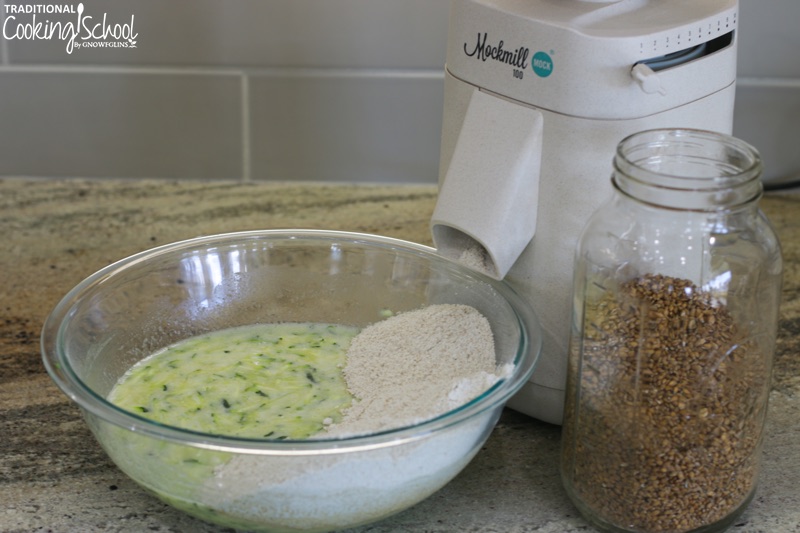
I keep sprouted einkorn berries on hand, which I then mill on-demand in my Mockmill home stone grain mill. As you can see in the photo above
The extra benefit? You don’t need to add any rest/soaking/souring time into the recipe if using pre-sprouted flour. Just mix and bake!
The Changes I Made To The Recipe
1. Because einkorn is less absorbent than regular flour, I needed to reduce the liquid in the recipe. I did this by cutting the oil in half and also squeezing the water out of the zucchini before adding it to the recipe. I prefer to do this than increase the flour, so that the sweetener-flour ratio stays the same.
2. I used coconut sugar instead of the white sugar, and I used about half as much as the original recipe. Any unrefined sweetener will do. You can even use an erythritol+stevia blend if you want to make it sugar-free.
3. I used sprouted einkorn flour. All the benefits of traditional methods, but none of the wait! 🙂
4. Mine baked for 60 minutes.
That’s pretty much it!
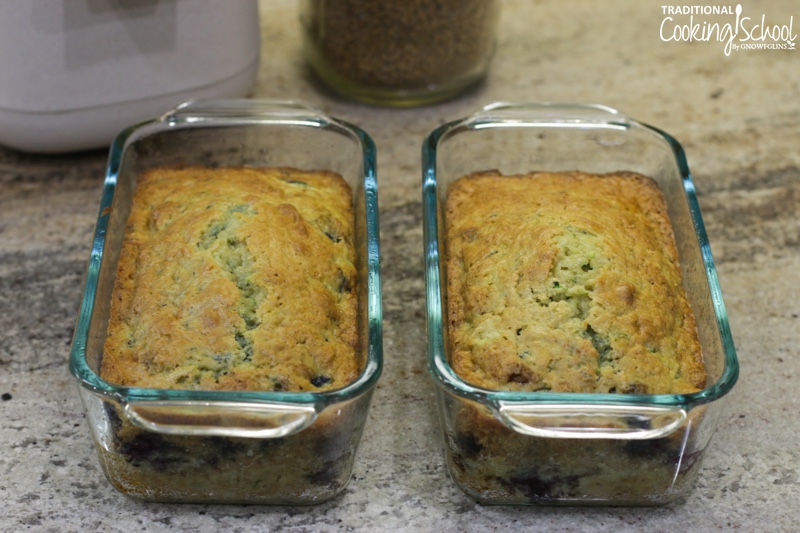
Sprouted Einkorn Blueberry Zucchini Bread
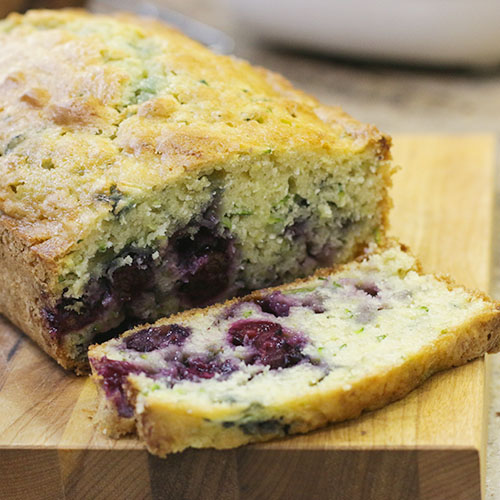
Blueberry Zucchini Bread
Have you ever wondered how to convert a non-traditional recipe into one that will be gut friendly and easy to digest? What if your recipe doesn't call for soaking or souring the flour? And can you swap regular flour for whole grain? There are basics to understand, but you absolutely can give a recipe, like this blueberry zucchini bread, a real-food makeover. Let us show you how!
Ingredients
- 2 cups zucchini shredded; about 2 medium zucchini
- 3 organic or pastured eggs lightly beaten
- 1/2 cup avocado oil or other healthy cooking oil such as melted coconut oil or butter
- 3 teaspoons vanilla extract
- 1-1/4 cups coconut sugar or other dry unrefined sweetener
- 3-1/2 to 4 cups sprouted einkorn flour fresh ground; otherwise start with 3 cups and add more as needed*
- 1 teaspoon sea salt
- 1 teaspoon baking powder
- 1/4 teaspoon baking soda
- 1 tablespoon ground cinnamon optional; for color
- 1 pint blueberries fresh or frozen
Instructions
-
Preheat oven to 350 degrees Fahrenheit and grease 2 loaf pans (with the oil mister!).
-
Grate zucchini and set aside.
-
Whisk together eggs, oil, vanilla, and coconut sugar.
-
Squeeze water out of zucchini, then stir into batter.
-
Stir in the flour**, salt, baking powder, baking soda, and cinnamon. Add more flour if needed.
-
Gently fold in blueberries. Transfer to prepared pans.
-
Bake for 50 to 60 minutes or until a toothpick inserted comes out cleanly. Cool 20 minutes, then turn out onto wire racks to cool.
Recipe Notes
*Here's how to make sprouted flour.
**I mill the sprouted einkorn berries right into the bowl, as the picture above shows. That's one reason I love the Mockmill so much! More info on the Mockmill right here.
Yummy! Enjoy!
Any Questions Or Comments?
If you have other questions or comments about your own experience, be sure to leave them in the comments!
Helpful Links
- The Oil Mister
- Free No-Knead Einkorn Bread Recipe
- Einkorn Baking eBook or eCourse
- Print Version of Einkorn Baking eBook
- FREE Traditional Cooking Video Series
What are your best tips for making recipes more healthy?
We only recommend products and services we wholeheartedly endorse. This post may contain special links through which we earn a small commission if you make a purchase (though your price is the same).


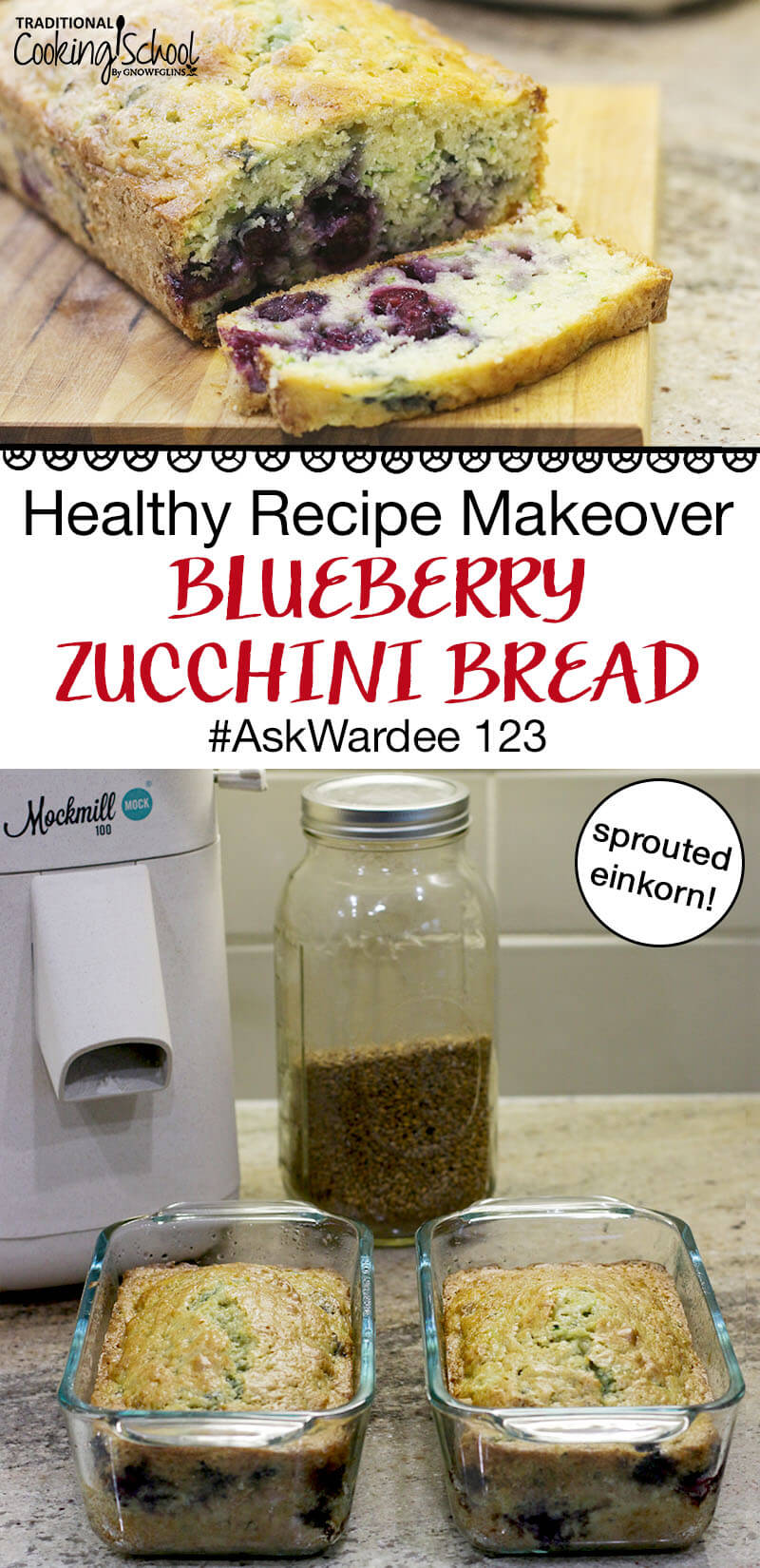
How much flour would I use for sprouted spelt flour.? Also on podcast you used only 1/2 cup of oil. Would I have to use more if using the sprouted spelt? I alternate between sour dough einkorn and spelt flour.
Hi Donna,
Using sprouted spelt flour is very similar to using sprouted einkorn flour.
Just follow Wardee’s recipe and add more sprouted spelt flour slowly, if needed, to obtain quick bread batter consistency.
~ Vicki, TCS Customer Success Team
Any reason I cannot substitute 8 oz of drained crushed pineapple instead of the blueberries?
Sure, Teresa. Go for it! 🙂
Be sure to drain them well so there’s not an over abundance of extra liquid in the recipe.
~Danielle, TCS Customer Success Team
When you use the MockMill to grind flour directly into the bowl is the amount of berries the same as the amount of flour? Since the flour is so light and fluffy I feel like it yields more than the berries.
Hi, Heather,
That is a great question! Wardee covered this in an #AskWardee episode here: https://traditionalcookingschool.com/food-preparation/how-much-flour-to-grind-askwardee-118/
~Peggy, TCS Customer Success Team
this bread looks delicious! could it be made using sourdough?
Hi Elizabeth.
It is delicious! 🙂
You can convert it if you’d like. Here’s our Ask Wardee on converting recipes to sourdough: https://traditionalcookingschool.com/food-preparation/convert-recipes-to-sourdough-aw043/
~Danielle, TCS Customer Success Team
Hi, is it possible to make this with un sprouted einkorn flour? I purchased the mockmill through you several years ago and I absolutely Love it! However I do not have a dehydrator to be able to spout my wheat safety, and I would like to make this recipe. Thank you
Wardee… you are a gift from Fathers heart to His body??
Hi Susan,
While we don’t recommend using unsprouted flours, you could use it if that’s all you have. Remember the sprouting process made the grains more nutritious and digestible.
There are sources to purchase whole grains that are already sprouted if you don’t have a dehydrator. Here’s one such source: https://amzn.to/31Kgz7w
~ Vicki, TCS Customer Success Team
Could almond flour be substituted to make this gluten free?
Hi Toni.
Although we haven’t made this recipe with it, you could try a gluten-free flour blend. A Straight swap to almond flour will not work.
~Danielle, TCS Customer Success Team
Hi Wardee,
I’m assuming that if I’m using unsprouted einkorn I could use the same amount as if I was using sprouted. Is that correct? Cup for cup?
Hi, Grace.
While we don’t recommend using unsprouted flours, you could use it if that’s all you have. Remember the sprouting process made the grains more nutritious and digestible.
We have not made it unsprouted so we can’t give guidelines on how much to use. 🙂
~Danielle, TCS Customer Success Team